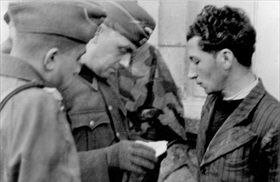FRENCH RESISTANCE TAKES ON WEHRMACHT
Mont Mouchet, South Central France · June 20, 1944
During the Allied invasion of France (Operation Overlord), the Maquis and other French resistance groups played a role in delaying the arrival of German reinforcements to the Normandy beachhead as well as in the eventual Allied victory in France. The FFI (Forces Françaises de l’Interieur for “French Forces of the Interior”) and Francs-tireurs sabotaged railroad tracks and repeatedly attacked German Army equipment and garrison trains on their way to Normandy. Thanks to coded messages transmitted over BBC radio, the maquisards (as Maquis members were known) were alerted of the impending D‑Day invasion by listening for pre-arranged messages read in a continuous flow over British airwaves.
As Allied troops advanced from their beachheads in June 1944, the FFI, whose ranks approached 200,000, rose against the Nazi occupation forces and their garrisons en masse. On this date in South Central France, one group of 7,000 maquisards (the group led by British Special Operations Executive [SOE] agent Nancy Wake, who was married to a Frenchman) began a series of pitched battles against upwards of 22,000 German soldiers. Between April and August 1944, Wake’s group accounted for 1,400 German casualties, while losing only 100 themselves.
On the Vercors plateau west of the French Alps, a Maquis group led resistants in establishing a short-lived Free Republic of Vercors in June and July 1944, which ended in defeat and civilian atrocities. When engaging the enemy, some Maquis groups took no prisoners, so enemy soldiers often preferred to surrender to Allied soldiers instead of facing the maquisards. Maquisards, whether captured by the Germans or by Vichy France’s Milice (French militia), faced torture, death, or concentration camps, where few survived (see photo essay below).
When Gen. Charles de Gaulle set up a Free French administration after liberating Paris in August 1944, many maquisards returned to their homes but many also joined the new French Army to continue fighting the Germans. France was rewarded for its tenacity against Adolf Hitler’s tyranny by joining the U.S., Britain, and the Soviet Union in stationing troops and administrating zones of occupation in a defeated Germany. The French zone lay to the east of the Rhine River, the decades-long contested boundary between France and Germany.
![]()
![]()
French Resistance Forces Target Both Germans and Collaborators
 |  |
Left: French resistance fighters with Francs-tireurs and Allied paratroopers share information during the Battle of Normandy, June 6 to mid‑July 1944.
![]()
Right: Members of the Maquis in the hamlet La Tresorerie near Boulogne-sur-Mer along the Pas-de-Calais coast, September 14, 1944. The female figure bears a close resemblance to the British SOE agent Nancy Wake.
 |  |
Left: The German text written by a German Armed Forces correspondent named Koll in July 1944, and associated with this photo, reads: “A good catch by German soldiers in France. The Communist leader is on the list of the wanted. His escape was thwarted by ‘Streif’ commandos. His papers prove his affiliation to terrorist groups.” A member of the Propagandakompanie der Wehrmacht, Koll titled his piece, “The ‘Red’ Resistance in France.”
![]()
Right: Koll’s text associated with this photo from July 1944 reads: “Arrested terrorists before deportation. The leaders of the gangs are Jews, who fled communist Spain [i.e., Republican Spain], and English [SOE] agents, who are usually well dressed and equipped with large sums of money. Their henchmen are recruited almost exclusively from work-shy rabble.”
 |  |
Left: Germany’s brutal occupation of Europe precipitated the rise of home-grown resistance movements that targeted members of the Wehrmacht (German armed forces) as well as supporters of collaborationist regimes like Marshal Pétain’s Vichy France—creating forms of civil war inside each occupied country. The Milice française, or simply Milice, was a Vichy paramilitary force formed in early 1943 with help from the Germans to fight the growing presence and armed capabilities of the French Resistance. Resistance fighters targeted miliciens for assassination, believing them more dangerous to their cause than the hated German Gestapo and SS. Koll’s text reads: “Members of the French Milice parade with shouldered armor-clad machine guns.”
![]()
Right: Koll’s text reads: “Numerous prisoners taken in an operation against the terrorists in France. Among them are many criminal elements who are guilty of murder, robberies, railroad bombings, etc. They are guarded by the Milice française, who stand shoulder-to-shoulder with German soldiers against Bolshevism.”
1944 Newsreel Account of the Liberation of France
![]()

 History buffs, there is good news! The Daily Chronicles of World War II is now available as an ebook for $4.99 on Amazon.com. Containing a year’s worth of dated entries from this website, the ebook brings the story of this tumultuous era to life in a compelling, authoritative, and succinct manner. Featuring inventive navigation aids, the ebook enables readers to instantly move forward or backward by month and date to different dated entries. Simple and elegant! Click
History buffs, there is good news! The Daily Chronicles of World War II is now available as an ebook for $4.99 on Amazon.com. Containing a year’s worth of dated entries from this website, the ebook brings the story of this tumultuous era to life in a compelling, authoritative, and succinct manner. Featuring inventive navigation aids, the ebook enables readers to instantly move forward or backward by month and date to different dated entries. Simple and elegant! Click 











